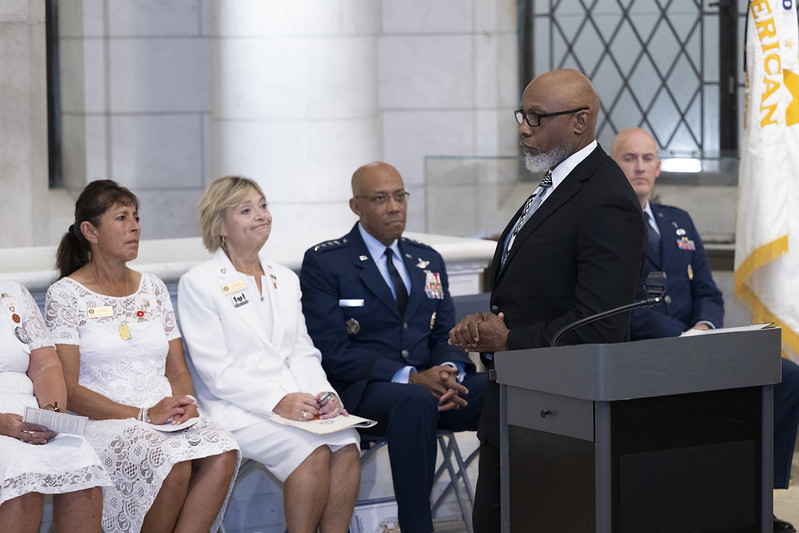
Retired U.S. Army Reserve Sgt. Maj. Ivory Hinton at the Gold Star Mother’s and Family's Day Ceremony, Sept. 29, 2024.
(U.S. Army photo by Elizabeth Fraser / Arlington National Cemetery)
Retired U.S. Army Sgt. Maj. Ivory Hinton had to pause several times to compose himself while addressing a group of Gold Star Mothers, civilians and U.S. military service members gathered in Arlington National Cemetery’s Memorial Chapel on Sept. 29, 2024, for the annual Gold Star Mother’s and Family’s Day. He paused the first time after listing three soldiers who were killed in Iraq under his command. “While I hold memories of each of them close to my heart,” he said before pausing, “it was Spc. Lucas Elliott who was the most recent KIA under my leadership in Basra, Iraq, on July 15, 2011.” He paused again, this time longer, before explaining how losing men under his command had tested his resolve.
Hinton turned around and looked at Pattie Elliott, Spc. Elliott’s mother, who was sitting behind him, wearing white and with tears in her eyes. “I still remember the day like it was yesterday,” he said, pausing again, “when I saw Ms. Patti on my return and we both embraced each other as tears flowed.” Hinton continued, “I somehow felt the loss in my heart as if Spc. Elliott was my own child.”
As U.S. Army Public Affairs Fellow Abigail Carey wrote in a 2023 blog post: "The origin of what would become Gold Star Mother’s and Family’s Day began with a simple accessory: a black armband with a gilt star. During World War I, family members would wear these armbands to represent a loved one who had died in the war. The stars would later find their way to being displayed on banners that were hung in windows or front doors. Banners with blue stars were hung to represent immediate family members who were serving. Some would have one star; others would have two or three. The stars symbolized the people who were supposed to be home but were missing from the dinner table. If a family member died during their service, the blue star would be replaced with a gold one."
In 1936, Congress designated the last Sunday in September as Gold Star Mother’s Day (now known as Gold Star Mother’s and Family’s Day). This special day honors the memories of those who served our nation, defended our freedom and made the ultimate sacrifice for our country. It is also a day to fulfill our nation’s obligation to care for our Gold Star families. Gold Star Mothers traditionally wear white for the ceremony.
The remembrance service included laying a wreath at the Tomb of the Unknown Soldier and laying roses at the Gold Star Mothers’ Tree (in nearby Section 2). Those who attended—attesting to the military’s commitment to families—included Chairman of the Joint Chiefs of Staff, Air Force Gen. Charles Q. Brown; Army Chief of Staff Gen. Randy George; Commandant of the Coast Guard Adm. Linda L. Fagan; and Acting Chief of the National Guard Lt. Gen. Jonathan Stubbs.

American Gold Star Mothers, Inc. President Patti Elliott and her son, Brad Elliott, lay a wreath at the Tomb of the Unknown Soldier, Sept. 29, 2024.
(U.S. Army photo by Elizabeth Fraser / Arlington National Cemetery)
Gen. Brown explained how those who serve their country occupy two worlds. “To us they were soldiers, sailors, airmen, Marines, guardians and Coast Guard—our brothers and sisters in arms,” he said. “But to you, they were your sons and daughters who you nurtured, raised and loved.”
After the service, several women reflected on the meanings of the day. “It’s always comforting and healing to be with my Gold Star Mother sisters,” said Judy Faunce, the mother of U.S. Army Capt. Brian Faunce, who was killed in Iraq on Sept. 18, 2023. “To feel their warmth and their comfort helps.”
To Courtney Chavez, the mother of Air Force Staff Sgt. Zachary Wood Lyon Jr. who died at Tinker Air Force Base in Oklahoma City on June 25, 2002, the ceremony meant her son’s “life, and what he stood for, still has value.” Theresa Karlson, the mother of Marine Corps Lance Cpl. Eugene “Gino” Mills III, who was killed in Afghanistan on June 22, 2012, stated: “We have your back, we will remember, and we will honor your sons and daughters as long as you shall live.”
Patti Elliott, who helped lay the wreath, spoke about the importance of the Tomb of the Unknown Soldier. “It’s symbolic of all of our heroes,” she said, “and without advances in technology, any one of our children could have been in an unknown grave.” She had no regrets about inviting Hinton to speak to her group. But, she admitted, “I didn’t know he would make me cry.”

Gold Star Mothers, Inc. members view the Changing of the Guard at the Tomb of the Unknown Soldier, Sept. 29, 2024.
(U.S. Army photo by Elizabeth Fraser / Arlington National Cemetery)
Learn More
► Listen to our recorded lecture, “Women, Mothers and the Tomb of the Unknown Soldier.”
► Read our previous blog post on the history of Gold Star Mother's and Family's Day.
► Explore our Education Program materials on the history of the Tomb of the Unknown Soldier—including women's key role in its creation.